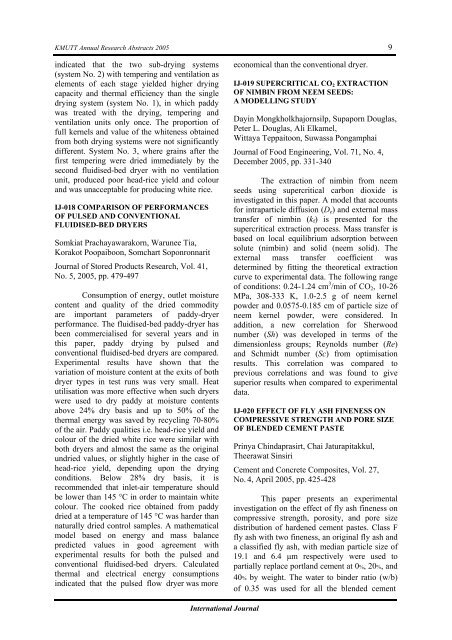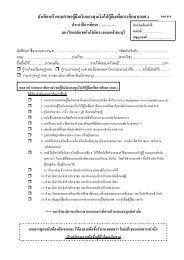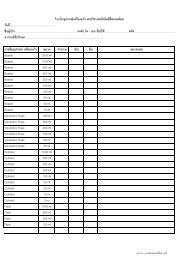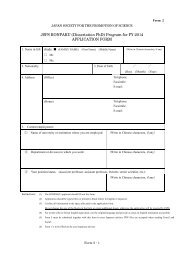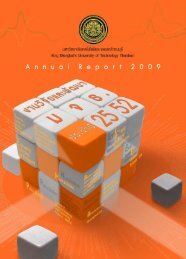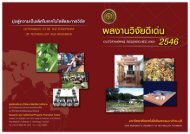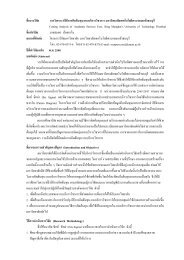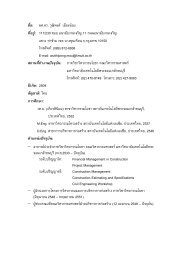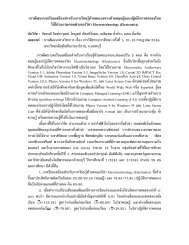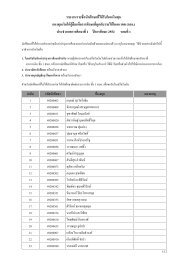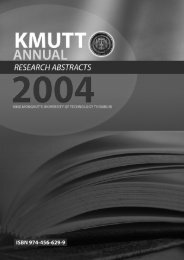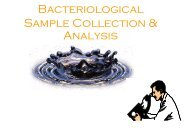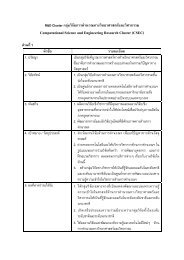You also want an ePaper? Increase the reach of your titles
YUMPU automatically turns print PDFs into web optimized ePapers that Google loves.
KMUTT Annual Research Abstracts 2005<br />
indicated that the two sub-drying systems<br />
(system No. 2) with tempering and ventilation as<br />
elements of each stage yielded higher drying<br />
capacity and thermal efficiency than the single<br />
drying system (system No. 1), in which paddy<br />
was treated with the drying, tempering and<br />
ventilation units only once. The proportion of<br />
full kernels and value of the whiteness obtained<br />
from both drying systems were not significantly<br />
different. System No. 3, where grains after the<br />
first tempering were dried immediately by the<br />
second fluidised-bed dryer with no ventilation<br />
unit, produced poor head-rice yield and colour<br />
and was unacceptable for producing white rice.<br />
IJ-018 COMPARISON OF PERFORMANCES<br />
OF PULSED AND CONVENTIONAL<br />
FLUIDISED-BED DRYERS<br />
Somkiat Prachayawarakorn, Warunee Tia,<br />
Korakot Poopaiboon, Somchart Soponronnarit<br />
Journal of Stored Products Research, Vol. 41,<br />
No. 5, 2005, pp. 479-497<br />
Consumption of energy, outlet moisture<br />
content and quality of the dried commodity<br />
are important parameters of paddy-dryer<br />
performance. The fluidised-bed paddy-dryer has<br />
been commercialised for several years and in<br />
this paper, paddy drying by pulsed and<br />
conventional fluidised-bed dryers are compared.<br />
Experimental results have shown that the<br />
variation of moisture content at the exits of both<br />
dryer types in test runs was very small. Heat<br />
utilisation was more effective when such dryers<br />
were used to dry paddy at moisture contents<br />
above 24% dry basis and up to 50% of the<br />
thermal energy was saved by recycling 70-80%<br />
of the air. Paddy qualities i.e. head-rice yield and<br />
colour of the dried white rice were similar with<br />
both dryers and almost the same as the original<br />
undried values, or slightly higher in the case of<br />
head-rice yield, depending upon the drying<br />
conditions. Below 28% dry basis, it is<br />
recommended that inlet-air temperature should<br />
be lower than 145 °C in order to maintain white<br />
colour. The cooked rice obtained from paddy<br />
dried at a temperature of 145 °C was harder than<br />
naturally dried control samples. A mathematical<br />
model based on energy and mass balance<br />
predicted values in good agreement with<br />
experimental results for both the pulsed and<br />
conventional fluidised-bed dryers. Calculated<br />
thermal and electrical energy consumptions<br />
indicated that the pulsed flow dryer was more<br />
economical than the conventional dryer.<br />
IJ-019 SUPERCRITICAL CO 2 EXTRACTION<br />
OF NIMBIN FROM NEEM SEEDS:<br />
A MODELLING STUDY<br />
Dayin Mongkholkhajornsilp, Supaporn Douglas,<br />
Peter L. Douglas, Ali Elkamel,<br />
Wittaya Teppaitoon, Suwassa Pongamphai<br />
Journal of Food Engineering, Vol. 71, No. 4,<br />
December 2005, pp. 331-340<br />
The extraction of nimbin from neem<br />
seeds using supercritical carbon dioxide is<br />
investigated in this paper. A model that accounts<br />
for intraparticle diffusion (D e ) and external mass<br />
transfer of nimbin (k f ) is presented for the<br />
supercritical extraction process. Mass transfer is<br />
based on local equilibrium adsorption between<br />
solute (nimbin) and solid (neem solid). The<br />
external mass transfer coefficient was<br />
determined by fitting the theoretical extraction<br />
curve to experimental data. The following range<br />
of conditions: 0.24-1.24 cm 3 /min of CO 2 , 10-26<br />
MPa, 308-333 K, 1.0-2.5 g of neem kernel<br />
powder and 0.0575-0.185 cm of particle size of<br />
neem kernel powder, were considered. In<br />
addition, a new correlation for Sherwood<br />
number (Sh) was developed in terms of the<br />
dimensionless groups; Reynolds number (Re)<br />
and Schmidt number (Sc) from optimisation<br />
results. This correlation was compared to<br />
previous correlations and was found to give<br />
superior results when compared to experimental<br />
data.<br />
IJ-020 EFFECT OF FLY ASH FINENESS ON<br />
COMPRESSIVE STRENGTH AND PORE SIZE<br />
OF BLENDED CEMENT PASTE<br />
Prinya Chindaprasirt, Chai Jaturapitakkul,<br />
Theerawat Sinsiri<br />
Cement and Concrete Composites, Vol. 27,<br />
No. 4, April 2005, pp. 425-428<br />
This paper presents an experimental<br />
investigation on the effect of fly ash fineness on<br />
compressive strength, porosity, and pore size<br />
distribution of hardened cement pastes. Class F<br />
fly ash with two fineness, an original fly ash and<br />
a classified fly ash, with median particle size of<br />
19.1 and 6.4 µm respectively were used to<br />
partially replace portland cement at 0%, 20%, and<br />
40% by weight. The water to binder ratio (w/b)<br />
of 0.35 was used for all the blended cement<br />
9<br />
International Journal


